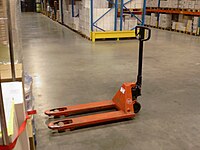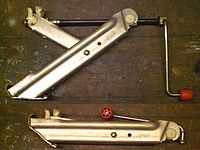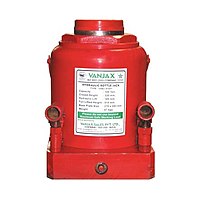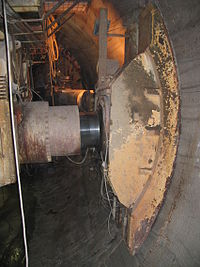Cat (device)
The jack is a machine used to lift heavy loads by manually operating a crank or a lever, or by means of a drive system assisted by an electric motor or by a compressor. air.
There are two types, according to their operating principle:
- Mechanical cats: they normally use a multiplier system based on a threaded piece and a spindle.
- Hydraulic Cats:
The most common forms are car jacks, and floor or workshop jacks, which raise vehicles so that they can be maintained, although there are also other types of special jacks that have multiple applications in construction or industry.
These devices are generally rated by their maximum lifting capacity (for example 1.5 tons or 3 tons), and for some applications it is also important to set the maximum distance the load can be moved.
Mechanical jacks
Mechanical jacks are preferably used for relatively small loads, and are often designed to be powered manually or by small motors (as in the case of jacks that are included in automobiles to replace a wheel in the event of a breakdown).
Its main advantages are its simplicity of construction, its minimum maintenance requirements, and its low price. On the contrary, its main drawbacks are its slow activation (and also retraction) and its limited load capacity.
This makes them suitable for applications for occasional use (such as the aforementioned case of the jacks that the vast majority of cars carry to replace a damaged wheel), in which simplicity and lightness prevail, even at cost of a slow and sometimes cumbersome operation. Likewise, in simple building processes (such as the fastening of formwork or falsework), very simple lifting mechanisms are used, which are merely systems of threaded rods, which are manually actuated with metal bars that are used as levers.
Principle of operation
The usual systems used in cats are based on simple machines (such as levers, gears or lathes), which use the principle of the equivalence of the moment of forces (a small manual force with a big lever arm ; is able to balance a greater force like the weight of a vehicle, but it has a very short action arm (c):
from which it follows that:
being the quotient the mechanical multiplication coefficient provided by the cat.
In terms of energy, a small force applied over a long distance is capable of displacing a large mass over a short distance. In a scissor jack, this coefficient (ignoring friction forces and the effect of changing the geometry of the quadrangle, which will cause the relationship between the horizontal displacement of the spindle and the vertical displacement of the support point to vary; in this example it is assumed that is being actuated when the four rods of the jack form approximately a square) depends on the length of the crank with which the jack is actuated, and the pitch of the thread that moves the spindle.
- Example
- In a normal scissor cat, the crank can measure about 20 cm, and the spin of the spindle, about 0.2 cm. This means that for every round full to the crank, the scissors move 0.4 cm (two millimeters for each of the two nuts in the spindle), and half distance at the top. The resulting multiplication coefficient in this case will be:
- This means that for every kilopodium of force applied in the crank of the cat, you can raise 628 kg, of which it is deduced that a person capable of exercising a modest force of two kiloponds, is able to izar more than 1200 kg.
Hydraulic jacks
Hydraulic jacks are used in applications that require a large load capacity, or maximum ease and speed of operation (especially in folding operations, which are immediate) for medium loads. Its main advantages are related to its power and speed, with the possibility of being controlled by servomechanisms, and with the minimization of mechanical losses associated with friction. Their main drawback is that they tend to be somewhat complex to maintain (especially in all aspects related to the absolute absence of leaks of the fluid used to transmit loads).
The fluids used are usually low-viscosity synthetic oils due to their ability to self-lubricate and their stability.
The most powerful jacks use electric pumps, capable of providing the necessary hydraulic pressure to operate over considerable distances and with the capacity to move large load tonnages.
Principle of operation
The operation of the hydraulic jack responds to Pascal's principle, which establishes that the pressure applied to a fluid contained in a closed container is transmitted uniformly in all its points.
The device, in its simplest form, has two plungers arranged in the shape of a "U", one of very small section (in which pressure is applied to the fluid by means of a lever or a pump), and the other with a very large section (where the load to be lifted is placed). The key to its operation are the one-way valves, which allow the passage of the fluid in only one direction. Thus, when the small plunger is actuated, a valve allows the passage of the fluid towards the larger plunger, but not its return. In the same way, a second valve allows fluid to enter from a reservoir towards the small plunger when the lever is raised, leaving the device ready for a new drive cycle.
According to the Pascal principle, the pressure is the same in the two emboles, which means between the small embole (with section) and strength ) and in the large piston (with section and strength , corresponding to the weight to izar), the equation is fulfilled:
which is equivalent to:
- ;
being the quotient the applied force multiplication coefficient.
- Example
- If the small piston has a section of 2 cm2, and the larger piston has a section of 100 cm2, despising the effect of the friction, the resulting multiplication coefficient in this case will be:
- This means that for every kilopodium of force applied in the cat lever, you can raise 50 kg, of which it is deduced that a person who supports part of his weight on the lever (about 20 kiloponds), is able to izar 1000 kg. It should also be borne in mind that for every inch that ascends the large piston, the small piston must travel 50 cm.
Pneumatic jack
It is a special type of hydraulic jack, which uses compressed air -for example, air from a compressor- instead of a liquid to produce the lifting effect. Some models designed to replace scissor jacks in the automotive industry consist of a cylindrical plasticized canvas or rubber bag, with sufficient resistance to be able to inflate with a pressure similar to that of a tire (about 2 kiloponds per cm²). and with the necessary size to hoist a car (a base of 50 cm² and a height of about 50 cm is enough to hoist 1000 kg) to replace a wheel. From an energy point of view, they are not very efficient (a lot of heat is released in the air compression process), but they can be useful to avoid manual efforts when there is a mechanized source of compressed air.
Technological evolution
Since ancient times there are examples of simple machines used to multiply the human or animal strength necessary to perform certain tasks (such as the construction of large stone monuments), as simple as inclined planes, or as complex as hoists, whose operating principles were already known in the time of Archimedes.
However, we must wait until the Renaissance (when practical and theoretical knowledge of how gears and threaded parts work began to develop) to find the first designs of mechanical mechanisms for lifting heavy loads (related to what today they are known as mechanical jacks); as attested to by some drawings from the XVI century contained in Leonardo da Vinci's Codex Atlanticus.
The enormous current diffusion of this instrument is associated with the rise of the automobile industry, which has been including it since its first models as an essential tool for replacing flat tires (the first cars equipped with a spare wheel inflated were the Ramblers in 1906.), although since the end of the century XX the decision has been gradually extended in some models to replace the spare wheel (and consequently, the jack), with a foam spray, which applied to a punctured wheel, allows you to drive a few kilometers to a workshop.
Regarding the hydraulic jack, despite the fact that the principle on which it is based has been known since the XVII century, when Formulated by the French physicist Blaise Pascal, it was not until 1851 that the American inventor Richard Dudgeon was granted a patent for a hydraulic portable press, now known as a hydraulic jack, a tool which proved to be far superior to the screw jacks used at the time. Dudgeon also designed other types of hydraulic jacks, such as those used for lifting rail vehicles.
Applications
In addition to their best-known and widespread use in the automotive industry, jacks have various applications in construction and industry, both for lifting or pushing heavy loads, and for stressing metal parts.
- Automotive
- Replacement of spare wheel
- Them Scissors cats cars use their mechanical multiplication capacity to allow a person to lift a vehicle (specifically to replace a flat tire) using only their manual force. The cat shown on the right is manufactured for a current vehicle, so the lifting muesque fits into a hard point of the body (monocasco) designed for the purpose. Old models used to have a platform to lift the frame or axis of the vehicle.
- Electrically operated car scissors cats operate the 12-volt power supply directly from the car's light box, avoiding the necessary effort on the part of the motorist for operation when manually operated.
- Maintenance workshops
- To lift vehicles quickly and easily, both in the wheel-change workshops and in the motor vehicle testing is widely used ground cat (also known as cat wheelbarrow), in which a handle of considerable length is transmitted through a hydraulic piston a vertical movement to a lifting pad, which is kept horizontal thanks to a joint. Ground cats typically include bearings to facilitate their displacement. This mechanism adopts a low profile when it is not driven to facilitate manoeuvres below the vehicle, while allowing a considerable extension.
- Construction
- Both in some construction works and in the construction of bridges (during their execution and then for the maintenance of elastic support), the use of hydraulic lifting or displacement cats is common, which in these cases are usually controlled electronically. Also, they are used for the teasing of metallic elements.
- Building
- The cats used in building are normally simple mechanical devices, used to facilitate the precise placement of certain auxiliary elements (such as encofrados or cimbras).
- Several of these cats are usually used (located at different support points) simultaneously, gradually driving them to facilitate the perfect leveling of the pieces being placed.
- Bridges of beams
- High-capacity hydraulics are used to controlledly lift large structural elements, such as prefabricated beams or bridge boards in repair or maintenance operations, such as the replacement of neoprene support.
- Inflated structures
- In this case, special hydraulic cats are used, endowed with large-length extensible pushers, which allow to slowly move an armed concrete structure to replace it below a communication track (usually rail) without the need to interrupt traffic.
- Stretched and pretensed bridges
- In pretensed concrete special hydraulic cats are used, capable of supplying the pretensed cables with the design tensions established for the structure, in a manner similar to what happens with the shaping bridges.
- Bridges pushed
- In this construction system, the board of a viaduct is being built on one of its stribes through successive sections. Each time a section is completed, the board (every longer) is pushed towards the next stage. The push is done by means of a hydraulic cat system, whose pistons lengthen and are collected at the end of each cycle.
- Industry
- Numerous machines use cats to settle, such as large tonnage car cranes; or tuner machines, which use them to position themselves and to drive against the ground.
- Railroad track assembly
- For the process of release of tensions associated with the aluminothermal welding of the continuous rails of the railroad track, special traction cats are used, which allow to apply the tension necessary to compensate the effect of the thermal expansion of the rail once welded.
Contenido relacionado
Signal electronics
Radio control
Link


























